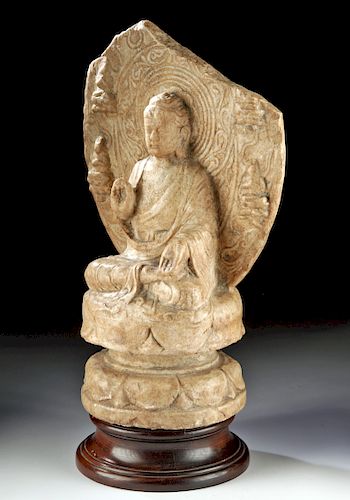Chinese Wei / Tang Marble - Buddha Shakyamuni
Lot 137
About Seller
Artemis Gallery
686 S Taylor Ave, Ste 106
Louisville, CO 80027
United States
Selling antiquities, ancient and ethnographic art online since 1993, Artemis Gallery specializes in Classical Antiquities (Egyptian, Greek, Roman, Near Eastern), Asian, Pre-Columbian, African / Tribal / Oceanographic art. Our extensive inventory includes pottery, stone, metal, wood, glass and textil...Read more
Categories
Estimate:
$9,000 - $13,000
Absentee vs Live bid
Two ways to bid:
- Leave a max absentee bid and the platform will bid on your behalf up to your maximum bid during the live auction.
- Bid live during the auction and your bids will be submitted real-time to the auctioneer.
Bid Increments
| Price | Bid Increment |
|---|---|
| $0 | $25 |
| $300 | $50 |
| $1,000 | $100 |
| $2,000 | $250 |
| $5,000 | $500 |
| $10,000 | $1,000 |
| $20,000 | $2,500 |
| $50,000 | $5,000 |
| $100,000 | $10,000 |
| $200,000 | $20,000 |
About Auction
By Artemis Gallery
Sep 26, 2019
Set Reminder
2019-09-26 10:00:00
2019-09-26 10:00:00
America/New_York
Bidsquare
Bidsquare : Exceptional Day 1: Antiquities & Asian Art
https://www.bidsquare.com/auctions/artemis-gallery/exceptional-day-1-antiquities-asian-art-4437
Day 1 of an important 2-day auction featuring exceptional, museum-worthy examples of Egyptian, Greek, Etruscan, Roman, Viking, Russian, Near Eastern, as well as Asian Art from China, Japan, Thailand, Vietnam, Burma and India. Artemis Gallery info@artemisgallery.com
Day 1 of an important 2-day auction featuring exceptional, museum-worthy examples of Egyptian, Greek, Etruscan, Roman, Viking, Russian, Near Eastern, as well as Asian Art from China, Japan, Thailand, Vietnam, Burma and India. Artemis Gallery info@artemisgallery.com
- Lot Description
East Asia, China, Northern Wei, Sui, or Tang Dynasty, ca. 500 to 800 CE. A striking devotional image, carved from a creamy white marble now colored with rich deposits, depicting the Buddha (Shakyamuni, the Enlightened form). He is seated atop a multi-tiered lotus throne with his legs crossed and his hands in the Abhaya-vara mudra, with one hand raised, palm out, and the other facing downward, palm out. This is the gesture of fearlessness, representing protection, peace, and dispelling fear. Behind him is a large, ovoid mandorla that was probably once capped by a flame. Projecting in relief around his head are four attendants, each seated with legs crossed and hands pressed together at the chest. The mandorla itself is beautifully decorated with incised circular and curved motifs. Buddha's robes are finely rendered, draped in a naturalistic way, while his facial features are serene and lifelike. His hair is styled with the classic large ushnisha that indicates his enlightenment. Size: 9" W x 14.2" H (22.9 cm x 36.1 cm); 16.5" H (41.9 cm) on included custom stand.
The Wei Dynasty represents the beginning of Buddhist influence on Chinese art. It was made in a region of China that had a great deal of contact with the outside world and was ruled by foreign monarchs. After the Wei Dynasty ended, Buddhist art continued to flourish throughout the Sui Dynasty and into the Tang, when it achieved a golden age. This was also an economic golden age in China, when imperial control of oases along the Silk Road allowed both the export of Chinese goods and the import of people and ideas from places like India, Persia, and even further afield. The capital city, Changan (modern day Xian) had 2 million inhabitants, making it one of the largest cities in the world at the time, and there was a large class of literati and artisans supported by the government who lived there. This artisan class had the luxury to produce beautiful sculptures like this one.
See a very similar depiction of the Buddha and attendants at the Osaka City Museum of Fine Arts, Japan: https://artsandculture.google.com/asset/seated-buddha-with-two-attendants/wAEGoHQBEEy45w and another at the Freer Smithsonian in Washington, D.C., USA: https://www.freersackler.si.edu/object/F1912.76/
Provenance: ex-private Boulder, CO collection
All items legal to buy/sell under U.S. Statute covering cultural patrimony Code 2600, CHAPTER 14, and are guaranteed to be as described or your money back.
A Certificate of Authenticity will accompany all winning bids.
We ship worldwide and handle all shipping in-house for your convenience.
#149421Losses at top of mandorla, as shown. Small chips, nicks, and scratches commensurate with age with some smoothing to features. Tiny losses from the fingertips of the raised hand. Otherwise in beautiful condition with rich deposits.Condition
- Shipping Info
-
All shipping is handled in-house for your convenience. Your invoice from Artemis Gallery will include shipping calculation instructions. If in doubt, please inquire BEFORE bidding for estimated shipping costs for individual items.
-
- Buyer's Premium



 EUR
EUR CAD
CAD AUD
AUD GBP
GBP MXN
MXN HKD
HKD CNY
CNY MYR
MYR SEK
SEK SGD
SGD CHF
CHF THB
THB













